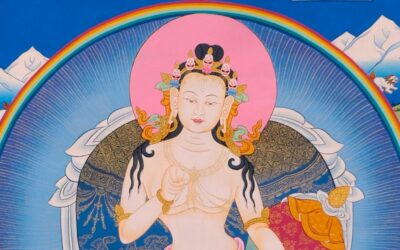The Friend of Good 1

Written By Mila Khyentse
Blog | Culture and tradition | History of Dzogchen | The Dzogchen basics
In this article, “The Friend of Good part 1”, Mila Khyentse talks about the Asian cradle of the spiritual figure of the Friend of Good.
The Friend of Good 1: The Asian Cradle
To address the question of the friend of good, the teacher, in the Dzogchen tradition, we need to look back to the (supposed) origins of this figure and function within the Asian cradle. We therefore need to take a leap back in time to at least 4000 BC and the constitution of the Indo-European world, even though the birth of the proto-Indo-European cultures is currently thought to be around 8000 BC.
According to Georges Dumézil, all populations of Indo-European culture – our nomadic herdsmen ancestors from the Turko-Mongolian steppes – have always had a triple social structure and have spread it wherever they have spread, or almost everywhere. Between 3500 and 800 BC, the Yamna culture, the best known, imposed a human social structure that we in the West have also inherited. This structure of society gave rise to a division into three parts, separating those involved in ‘sacred’, ‘military’ and ‘productive’ functions.
In the Indian world, it gave rise to the “varṇa” (“colour” and “rank” in Sanskrit) during the Vedic period. The Rig-Veda says that the primordial man, the puruṣa, gave birth to the four varṇa, in verse 12 of the Hymn to the Puruṣa: “His mouth became the Brahman; the Warrior (rājanya, equivalent to kṣatriya) was the product of his arms; his thighs were the Craftsman (vaiśya); from his feet was born the Servant (śūdra)” [1]. These varṇa, called castas (castes) by the Portuguese missionaries, from then on hierarchized all Indian society, creating “virtuous pairs”: the first two: priests and kings (or warriors), and the last two: merchants and servants. The latter was long considered a “non-color”.
These are the first two colors that have always formed the backbone of power in all Indo-European societies. The Raja rules on earth, and the Brahman is the representative of the gods, a messenger of their will to mankind and a sacrificer of offerings to the gods. This model of power quickly became established everywhere, from the Chinese Far East to the European Far West.
Thus, in the history of humanity, the spiritual master is above all a being who accompanies, advises and nurtures, because his knowledge, his wisdom, is not of this world, i.e. is not worldly. He advises kings and rulers to make the right decisions, and the fact that he can “talk” with that which remains invisible to most people sets him apart. He is respected, even revered, throughout Asia, and is indispensable to mankind as he can show the way to liberation, and, in some Asian societies, even liberate directly from suffering. His social status is therefore one of the highest, sometimes even the highest in many places.
In the Asian world, it is said that it is very necessary to know well the master, the friend of good, to whom one commits oneself.
The Tibetan world has inherited the Indo-European tradition in that the model of the teacher comes directly from the Indian world, with the simultaneous introduction of Buddhism and Dzogchen as early as the 8th century.
The kings Songtsen Gampo, Trisong Detsen and Tri Rälpachen of the 7th-9th centuries, known as the “three religious kings”, disseminated and implanted the Indian tradition of the priest-king couple, which became the very backbone of classical Tibetan society. A specific Tibetan term, mchod yon, often rendered as “patron-priest”, expresses this fundamental reality of Tibetan history and tradition. Tibet gradually evolved towards a fusion of this dual role into a single one, notably in the 13th century with the Kheun (‘khon) family of the Sakyapa lineage and, of course, in the 18th century with the “Great Fifth”, the Fifth Dalai Lama, who became the temporal ruler of Tibet in 1742.
Although the Dzogchen tradition is somewhat less conventional than that of Tibetan Buddhism, in that many of its holders were of low birth, the fact remains that as this tradition developed on Tibetan soil, they were very often regarded as “mi chenpo“, “great men” by all classes of society.
Thus, in the Asian cradle, the figure of the master, the good friend, quickly became hierophantic and hieratic, imbued with respect, associated with sacred power.
Nevertheless, another figure of the master, that of the “forest tradition” (the śramana of Jainism or Buddhism in particular), has been maintained from the outset alongside that of the orthodox hierarch. It is rooted in the ascetic tradition of withdrawal from the world into the forest – as Buddha did in his time – and has developed into the tradition of yoga practitioners: yoginis and yogis. Many are, as we saw above, of low birth or, more rarely, of high birth, but have renounced the world. They teach in secluded places, in the mountains, in the desert or in the forest, and very often share a common trait: an unconventional attitude. This makes them difficult to follow as masters, unless you appreciate this absolute freedom from any conformist order!
The Tibetan world has also placed great emphasis on this forest tradition, transposing it to the mountains and their deserted peaks. Names like Do Khyèntsé Yéshé Dorjé, Pältrul Rinpoché or even the 6th Dalai Lama are enough to evoke colorful figures who have always been on the fringes of society, but deeply rooted in this tradition of the original yogis. Over the centuries, however, this tradition has tended to be eclipsed by the institutional tradition of the monasteries. It’s also worth noting that many accomplished yogis founded a lineage and/or were at the origin of the founding of monasteries.
For us in the West, who have generally lost sight of this reality of our roots – which has also cemented our society for millennia [2] – the relationship with a friend of good is a sign of submission and dependence. Isn’t one of the current credos of the Western “spiritual movement”: “no god, no master”?
Not in Asia. Not in the Asian cradle of the great traditions of humanity, even today. This “dependence” is a different kind of relationship, where respect is combined with humility, but not subservience. We serve out of gratitude and love, but we are not “erased” as individuals. Roles, functions and responsibilities are clearly defined and nothing is confused. A spiritual master teaches, a student listens and applies. Not the other way round, nor anything else. If there’s a mistake, on one or both sides, the relationship ends. It wasn’t right. There are no regrets. Just try again.
Not knowing the roots of the ‘exotic’ tradition you are exploring is a big mistake: you don’t know the rules, you don’t know how to act and you don’t know how to behave. So we imitate without understanding, which leads to much more confusion than wisdom.
In the Asian world, it is said that it is very necessary to know well the master, the friend of good, to whom one commits oneself. It is also necessary to know the kind of (healthy) relationship that is based on a willingness to learn, to practice a path of liberation and the trust that comes with it. Finally, it is essential to know the context of this relationship in order to be able to develop it, if necessary, towards a real encounter with oneself, one’s culture and one’s convictions.
There is a Tibetan proverb that says: “Only a man in goat’s clothing [3] can follow a wolf in human clothing”. Which means: “Respect is never blind”.
Finally, it’s interesting to note the current evolution in thinking about how to follow a spiritual path of Asian origin in a Western style. This means that the first period of nuptials is over, the one where you feel like you’re flying on a little pink cloud, and now it’s time to make an effort if you want your relationship to really work and last. We can’t do that if we don’t look back at the reality of the origins and roots of what these paths are all about, one of the central lynchpins of which is the notion of authentic transmission from a friend of good who has already walked the path of liberation to a student who is just beginning.
[1] Purusha Sukta: https://en.wikipedia.org/wiki/Purusha_Sukta BACK
[2] More on this in the next article. BACK
[3] They correspond to our sheep.
More Posts
The ground of all Künshi
This article “The ground of all, Künshi” provide a better understanding of the essential words and concepts of Dzogchen.
The Four Testaments of the Vidyādharas
This article from Grégoire presents the" Four Testaments of the Vidyādharas", essential teachings from the early masters of Dzogchen.
The Story of the First Masters: Garab Dorje
“The Story of the First Masters: Garab Dorje” is the first article in a new category about the masters of the Dzogchen lineage.




